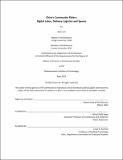| dc.contributor.advisor | Segal, Rafael (Rafi) | |
| dc.contributor.author | Lan, Xuan | |
| dc.date.accessioned | 2022-08-29T16:13:28Z | |
| dc.date.available | 2022-08-29T16:13:28Z | |
| dc.date.issued | 2022-05 | |
| dc.date.submitted | 2022-06-16T20:26:00.234Z | |
| dc.identifier.uri | https://hdl.handle.net/1721.1/144814 | |
| dc.description.abstract | With the rise of digital platforms, delivery workers using motor scooters (hereafter referred to as “riders”) have gained new prominence through providing essential mobility in urban geographies. Throughout the COVID-19 pandemic, food delivery riders have become a fixture of China’s streets by forming an instant, all-weather, community-based logistic network. In early 2021, more than 7 million riders delivered 65% of daily essentials and served 430 million customers, which constitutes 30% of China's population. As both capital and labor flowed into this booming e-commerce industry, tech giants fiercely competed to offer the most cost-effective food delivery platforms by implementing algorithmic control of the riders. The majority of riders are young migrant workers, struggling to make a living by taking delivery as their entry job in cities. Even though China is moving to protect riders from digital exploitation, conflicts are arising in both social and spatial aspects.
This thesis undertakes a critical investigation into China's delivery riders by analyzing their mobility services in community-based logistics and proposing spatial tactics to improve their work and well-being. By examining the delivery network and the digital exploitation behind it, the thesis reveals the mechanism of the system's gamified control over the labor conditions. It reviews the plight of China’s food delivery riders, laboring under digital exploitation conditions mirroring those of workers worldwide in the new gig economy. This thesis also demonstrates that urban spaces in cities are incompatible with this booming rider group, resulting in a slew of unsolvable issues like street crowding, disorderly parking, traffic congestion, and vehicle-pedestrian collisions. By uncovering these challenges, this thesis calls for an intersectional perspective to address the riders' digital and physical conditions. It seeks to develop potential interventions in cities to reduce spatial and social inequalities. Prototype proposals shown create better suited spaces for riders by improving their working conditions: spaces of moving, pickup/drop-off and rest. | |
| dc.publisher | Massachusetts Institute of Technology | |
| dc.rights | In Copyright - Educational Use Permitted | |
| dc.rights | Copyright retained by author(s) | |
| dc.rights.uri | https://rightsstatements.org/page/InC-EDU/1.0/ | |
| dc.title | China's Community Riders: Digital Labor, Delivery Logistics and Spaces | |
| dc.type | Thesis | |
| dc.description.degree | S.M. | |
| dc.contributor.department | Massachusetts Institute of Technology. Department of Architecture | |
| mit.thesis.degree | Master | |
| thesis.degree.name | Master of Science in Architecture Studies | |
